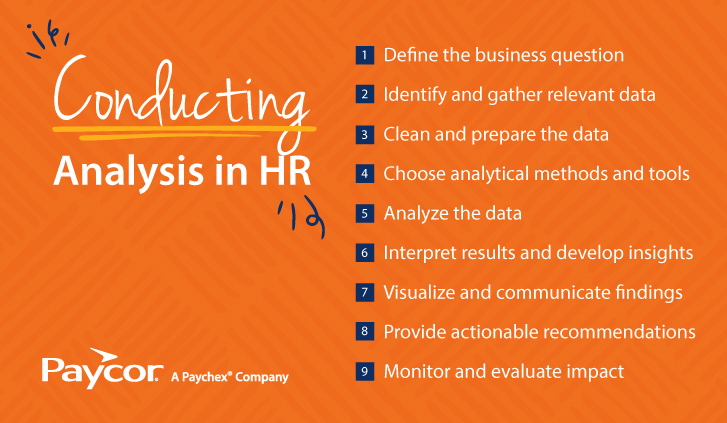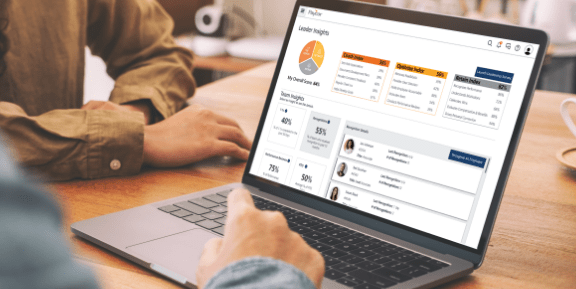Businesses might operate on capital, but employers are more readily recognizing in a rapidly changing landscape that businesses operate because of people. The same curve holds true for decisions regarding talent, which until recently relied mostly on intuition. That’s changing. It must if businesses want to thrive rather than simply sustain, or worse yet, fail because talent acquisition and workforce planning were not a higher priority.
The numbers from a recent report are sobering: 73% of businesses conduct workforce planning that links strategies to future needs, but only 12% of HR leaders in the United States engage in strategic workforce planning with at least a three-year focus (McKinsey).
HR analytics is the answer to bridging that gap.
Here we’ll discuss the details of HR analytics while exploring the diverse types that empower businesses to make smarter, more impactful decisions about their most vital resource.
What is HR Analytics?
HR analytics is methodical process of collecting, analyzing, and interpreting people-related data to inform business decisions. This helps human resources to move beyond its long-held administrative role and, instead, become a strategic partner in organizational success.
Types of HR Analytics
There are different types of HR analytics, all of which build on each other to offer deeper insight into a business’s workforce. These include:
- Descriptive analytics: This type uses historical HR data to help identify patterns, trends, and outcomes that offer a better picture of the current state of the workforce. HR professionals can use the data to understand past performance, identify areas for improvement, and gauge the effectiveness of existing HR policies.
- Predictive Analytics: Predictive HR analytics uses historical HR data, statistical models, and machine learning techniques to forecast what is likely to happen—in the future. Unlike descriptive, it identifies patterns and relationships in data, which helps spotting opportunities and risks. This puts HR on offense rather than defense.
- Prescriptive Analytics: The most advanced type of HR analytics, prescriptive analytics, takes the insights from descriptive and predictive analysis and recommends action plans to achieve desired outcomes. HR can make data-driven decisions based on “what should we do” with insights gained from leveraging complex algorithms, machine learning, and simulations that suggest specific interventions.
Primary Goal of HR Analytics
The main goal of HR analytics is to transform HR from a reactive, administrative function into a proactive, strategic partner within a business that identifies challenges and opportunities and establishes a strategy to act upon. This is especially important for talent development.
Businesses will discover transformative results from leveraging the data and deep insights offered by HR analytics. By learning from the past and studying what’s happening now, businesses can make better decisions and prepare for the future.
Why is Data Analytics Important?
HR analytics helps businesses use data to improve employee experience, engagement, productivity, resilience, and costs while directly and positively influencing HR goals and objectives.
By analyzing metrics like turnover, engagement, and performance, HR professionals and teams can identify root causes of issues and then optimize strategies accordingly.
For instance, understanding why top performers leave allows HR to create targeted retention efforts, that analyze recruitment data to refine hiring processes and attract the best talent.
Benefits of HR Analytics
There are numerous benefits to HR analytics. To name a few:
- Data-driven decision making: Moves HR from intuition to evidence-based strategies.
- Talent acquisition optimization: Improves recruitment efficiency, quality of hire, and time-to-fill positions.
- Employee engagement and experience: Identifies factors influencing satisfaction and designs targeted interventions.
- Employee retention: Pinpoints at-risk employees and underlying causes of attrition, reducing costly turnover.
- Workforce performance: Analyzes performance data to identify high achievers, skill gaps, and development needs.
- Strategic workforce planning: Forecasts future talent needs, identifies skill shortages, and builds robust pipelines.
- HR-related costs: Minimizes expenses associated with high turnover, inefficient hiring, and ineffective programs.
- Business value: Provides quantifiable evidence of how HR initiatives impact the bottom line.
HR Analytics Data Metrics
There are several HR metrics you can monitor with HR analytics. But here are a few of the most important to monitor:
- Voluntary turnover rate: This metric calculates the percentage of employees who voluntarily leave an organization within a specific period (e.g., quarterly or annually). It’s a key indicator of employee satisfaction, organizational culture, and the effectiveness of retention strategies.
- Time to hire: This measures the average number of days it takes to fill an open position, from job posting to a candidate accepting the offer. It is crucial for evaluating the speed of the recruitment process and identifying potential bottlenecks in hiring.
- Employee engagement score: An example is the Employee Net Promoter Score. This metric (often derived from employee surveys or specific tools like eNPS) quantifies how connected, committed, and motivated employees feel towards their work, their team, and the organization.
- Cost per hire: This represents the average financial investment an organization makes to recruit and onboard a new employee. It includes recruiter salaries, referral bonuses, advertising, and background checks). Monitoring this helps optimize recruitment budgets and identify cost-effective hiring channels.
- Absenteeism rate: Measures the percentage of scheduled work time that is lost due to unscheduled employee absences (e.g., sick leave, no-shows). A high absenteeism rate can indicate issues such as burnout.
Conducting Data Analysis in HR

Whether you’re trying to reduce turnover, boost engagement, or figure out which benefits actually matter, a structured approach to data analysis can help you make smarter decisions. Here’s how most HR teams break it down:
Define the Problem or Objective
Before diving into spreadsheets, get clear on what you want to solve. Are you trying to understand why retention is dipping? Hoping to measure the impact of a new training program? Pinning down your question keeps everything focused and helps you avoid wasted effort later on.
Collect Relevant Data
Decide what data you need and where it’s coming from. This could be internal (like employee surveys, performance reviews, or payroll records) or external (industry benchmarks, labor market stats). Make sure your data is accurate, up-to-date, and ethically sourced.
Clean and Prepare the Data
Raw data is almost always messy. You’ll need to tidy it up—remove duplicates, handle missing values, standardize formats, and make sure everything makes sense. This step isn’t glamorous, but it’s critical for meaningful analysis.
Explore and Analyze the Data
Now you can start digging in. Use statistical tools or visualization software to spot patterns, trends, or outliers. Maybe you notice that turnover spikes in a certain department, or that engagement drops after annual reviews. This is where you start forming hypotheses about what’s really going on.
Interpret the Results
Numbers alone don’t tell the whole story. Translate your findings into plain English (or whatever language your audience speaks). What do the results actually mean for your business? Are there clear actions to take or decisions to make?
Communicate Insights and Recommendations
Package up your analysis so others can understand it—think dashboards, reports, or presentations. Highlight key findings, recommended actions, and any limitations. Good data means nothing if nobody gets the message.
Implement Changes and Monitor Outcomes
Put your recommendations into practice and keep an eye on the results. Did the new onboarding program actually improve retention? If not, go back to your data and try again. Data analysis in HR is a cycle, not a one-and-done event.
By following these steps, HR teams can move from hunches and guesswork to decisions grounded in evidence—making it easier to build workplaces where people actually want to stick around.
Challenges of HR Data Analytics
If you’re diving into data analysis, don’t assume it’s all smooth sailing. The buzz around people analytics is loud—almost every executive claims it makes HR indispensable. But beware: the reality often falls short of those lofty expectations. And even if you set aside that gap, you’ll find plenty of other hurdles waiting as you try to make data actually work for your HR challenges.
- Data quality and accessibility: Data often resides in multiple systems (e.g., ATS, payroll, LMS), which leads to inconsistencies and inaccuracies. Attempts to merge the data and clean it up adds a time element and could undermine the reliability of insights.
- Lack of data literacy: Many HR professionals might not possess the statistical knowledge or skills needed to effectively interpret complex data sets. In 2024, just 8% said their HR analytics skills were strong (Market.us). This could lead to failure to extract actionable insights.
- Data privacy/security concerns: A layer of complexity is added to any analysis because of the need to adhere to privacy regulations and robust security measures.
- Leadership resistance: Adoption and implementation requires buy-in from leaders, so shortcomings in understanding the value of the HR data analytics process or failure to align HR initiatives with strategic business goals could result in a lack of necessary support.
How to Get the Most Out of HR Data Analytics
If you truly want to get the most out of your HR analytics, here are some tips to help you make HR analysis easier, more effective, and more productive execution:
- Clarify the Business Problem: Start by pinpointing the exact issue you want to solve—whether it’s reducing turnover or controlling overtime expenses. Bring in key stakeholders early to make sure your question targets a meaningful business need.
- Locate and Collect the Right Data: Identify all the systems that store the data you’ll need. Lay out where your information lives so you can gather it efficiently, without scrambling at the last minute.
- Prepare the Data for Analysis: Use automation to handle repetitive data-cleaning tasks, cutting down on manual work and minimizing errors.
- Select the Right Analytical Approach: Choose analysis methods and tools that fit your team’s strengths. This helps ensure your team can execute effectively without a steep learning curve.
- Conduct the Analysis: Tackle large analytical projects in smaller, manageable pieces. Test your assumptions iteratively as you go.
- Draw Meaningful Conclusions: Look beyond the numbers. Focus on uncovering actionable trends and understanding why they happen, not just what’s happening.
- Present Insights Clearly: Build a narrative around your findings that speaks directly to your audience and highlights the business relevance of your results.
- Recommend Specific Actions: Make sure each recommendation is practical and rooted in your analysis. For example, if you discover what employees value most in insurance, use that to craft a stronger benefits package.
- Track Outcomes and Refine: Set up ongoing reporting to see how your recommendations play out in practice, showing the real-world impact of your analytics work.
How Paycor HR Analytics Helps
Paycor offers a comprehensive suite of Human Capital Management (HCM) solutions, and HR Analytics is a core component of its various product offerings. Robust analytics capabilities are embedded within its different modules to provide insights from various HR functions.
Paycor Analytics brings together data from across your Paycor platform. It’s designed to provide high-impact, easy-to-consume, real-time data insights without requiring users to be data analysts.
Core HR & Payroll software is a foundational module that collects vast amounts of employee data (e.g. workforce demographics, payroll costs and trends, compliance reporting) that fuels HR analytics.
Talent Management software is a suite covering recruiting, onboarding, performance, and development that all contribute to data analytics.
Workforce Management software, which includes Time & Attendance and Scheduling products, are crucial for understanding labor costs and productivity.
Monitor Your HR Data and Analytics with Paycor
Paycor’s approach to HR Analytics is deeply integrated into its entire HCM platform, which leverages data from payroll, core HR, talent acquisition, talent management, and workforce management to provide a holistic view of the workforce.
The right software empowers HR leaders to focus on strategy. Customers that switched software providers to Paycor streamlined their businesses by reducing the number of HR tools and people management systems they were using by 184%.
Learn why 30,000+ customers choose Paycor for their HR software of record. Request a guided product tour.
HR Analytics FAQs
Do you have additional questions on HR data analytics? Read on.
How Does HR Analytics Improve Business?
Businesses using HR analytics improve with the addition of data-driven insights on the workforce, which enables better decision-making that optimizes talent, reduces costs, and enhances overall organizational performance. Strategically aligning people initiatives with key business objectives drive growth and profitability.
What Are the 3 Main Types of HR Analytics?
The three main types of HR analytics are descriptive, predictive, and prescriptive.
What is the Difference Between HRIS and HR Analytics?
A Human Resources Information System (HRIS) primarily manages and stores foundational employee data and automates core HR administrative tasks (e.g., payroll, benefits administration). In contrast, HR Analytics is the process of analyzing the data collected by an HRIS (and other sources) to extract insights, identify trends, and inform strategic decisions.
How Does HR Analytics Improve Employee Performance?
HR analytics identifies key factors that improve employee performance, including effective training programs and leadership behaviors. Analyzing performance data, for example, enables HR personnel to get ahead on interventions and implement personalized development plans. This could boost individual and ultimately team productivity.
How Does Effective HR Analytics Impact Employee Retention?
Effective HR analytics provides predictive insights into turnover risks, so businesses can address issues before employees leave. By understanding engagement, compensation, or manager effectiveness through data, HR can implement meaningful retention strategies that boost satisfaction and commitment.
How Does HR Analytics Improve Employee Productivity?
HR analytics improves employee productivity by identifying factors that hinder or enhance performance. These include skill gaps, ineffective training, or workload imbalances. By leveraging data, businesses are able to intervene with options for professional development , which approach empowers employees and enhances their output.
How is HR Analytics Impacted by AI?
The most significant impact of AI in HR is the ability to process speedily massive amounts of data, while uncovering unseen patterns that allow for more accurate predictions. This moves HR beyond simply reporting on past events to proactively forecasting trends and making more strategic and impactful decisions.









